Nixtamal And The 24 Hour Taco!
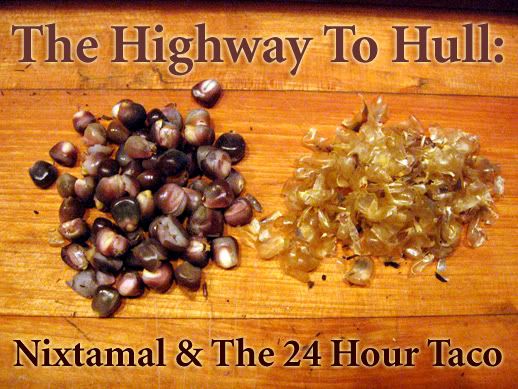
Despite the following blog detailing my experiments, I still have no idea how to nixtamalize corn. Even after finding a video on YouTube, I still have a zillion unanswered questions. Though I have mostly given up eating corn, I still would like to know how the process works.
Everyones that I have an addiction to corn chips. I love the way they crunch and crackle like nothing else, and I love them even more with salsa and guacamole. My journey into the process referred to as nixtamalization came after I ate several bags of blue corn chips in one sitting while I tried to eat the Body Ecology Diet, which allowed blue corn chips in small doses. I told myself that should I eat chips again, I should have to process them from corn to chips myself.
What do you need to make chips? Tortillas. I went to the store and bought a bag of blue corn meal, and without looking at a recipe, tried to make tortillas. I thought, corn meal, water, some oil and a pan right? Wrong.
Of course, I failed miserably. So I did a little more research and found that corn meal does not make good tortillas. Corn flour, a finer grind of corn meal, makes better tortillas. But I also read about several different kinds of corn flour, specifically one they call “masa harina.” I found that this corn flour has something extra to it. Masa harina basically means; nixtamalized corn flour.
Nixtamal (also called hominy in the states) refers to an Aztec word that translates to “corn softened in wood ashes.†It combines two Aztec words; “nextli†which means “ashes†and “tamalli†which means “unformed corn dough.†To make nixtamal, one cooks/soaks corn in an alkaline solution such as lime water or lye. This causes the outer hull to separate from the grain, making it much easier to grind and simultaneously making nutrients in the corn more available to humans. Now you can see the reason I became interested in nixtamal; it made corn more nutritious. If I can’t kick the corn at least I can make it a little more nutritious!
I found one online recipe, and one from the book Wild Fermentations. The online recipe called for store-bought hydrated lime (AKA “Cal”) and the Wild Fermentations recipe called for wood ash. I thought wood ash would feel cooler, since it doesn’t involve going to the store or spending money.
I bought a big bag of blue corn from Bob’s Red Mill:
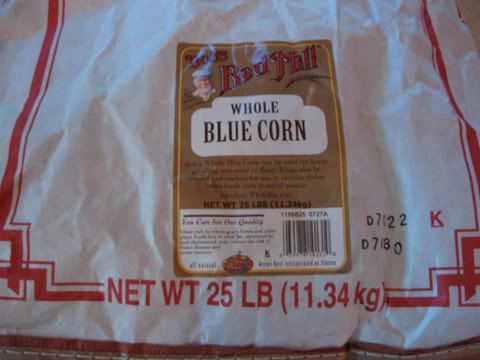
They say to use a hard wood so I burned some cherry cut from a near-by park.
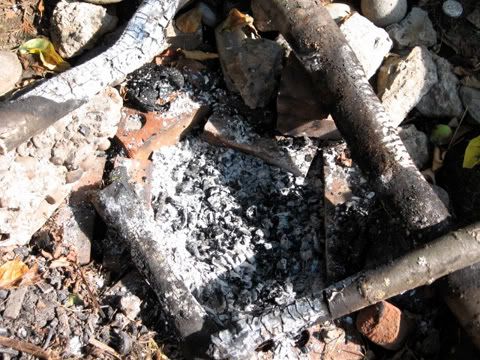
I scooped up the ashes into a cup and sifted out the big charcoal chunks.
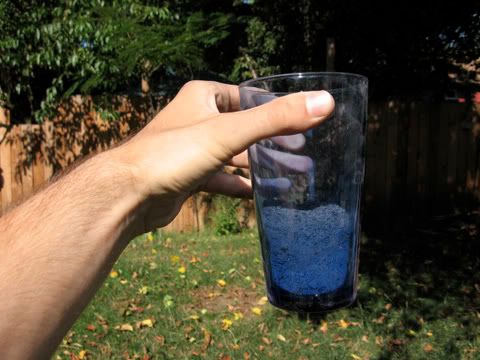
I wanted to do it all scientificamally so I bought a PH test kit. I tested the PH in hopes that I would learn what the proper PH for lye water something something I have no idea why I did it, but it felt fun.

Next I took three samples. I had read a million different pieces of the puzzle across the internet on the proper way to make nixtamal. Though I had two solid recipes, they both lacked some tidbits I had read here and there. For example, the Wild Fermentations recipe has you sprout the corn first by soaking it in water for 12-24 hours, but the online recipe I found did not call for that. I think sprouting probably helps get rid of hazardous enzymes, so I went with that.
I felt that a way must exist that uses less energy than both of the recipes that I found. Boiling for three hours seems like a long time, and finding hydrated lime probably didn’t come as easy as walking into a grocery store for hunter-gatherers. I decided to try and soak the corn in ash-water for a long period of time to see if it would naturally penetrate the hull.
The three samples looked like this:
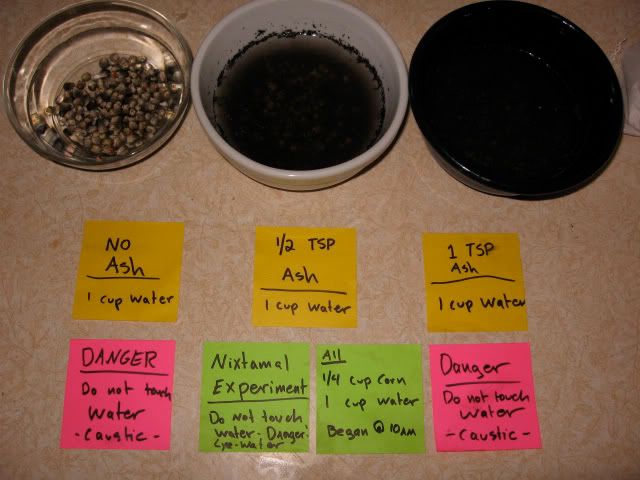
After several days of watching them closely and checking the PH regularly…

…they got moldy.
Now, the internet recipe says to boil in slaked lime water for 30 minutes and let soak overnight. The Wild Fermentation recipe says to boil in ash water for 3 hours. It seems ludicrous to boil something using primitive technology like hot stones or pottery. Heating stones hot enough to boil water takes a lot of energy, and to have them continuously for 3 hours seems an awful long time to me. So I though I’d split the difference and use the ash-water in place of slaked lime and only boil for 30 minutes and let it sit over night. I also sprouted this batch.
It failed. The ash water did not have the strength of the slaked lime water apparently.
Just when our chips fell down, Penny Scout found this awesome Indian Corn Soup video:
[kml_flashembed movie="http://www.youtube.com/v/uFgkhJZ-CeA" width="425" height="350" wmode="transparent" /]
Now… See how much ash that guy uses!?! A big fucking bowl full. The Wild Fermentations recipe has you only use a teeny tiny bit. Like… 1/2 a cup of ash to 8 cups of water. I think that may have something to do with the boiling for 3 hours. The native in the video only boils his for 30 minutes. Though, he makes corn soup and not tortillas. But it seems more likely that that amount of ash may equal a small amount of slaked lime.
I decided to screw my own experiments and use the rest of the ash to follow the recipe in Wild Fermentations, exactly the way it says. I boiled the corn for 3 hours and still did not have success. I just let it keep boiling and after about another 30, the hull’s began to come off.
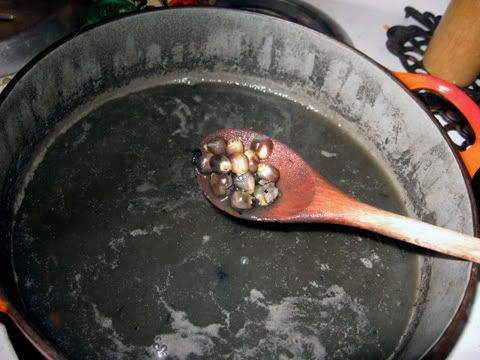
It says the hull’s should rinse away under cold water, but my hulls stuck to the germ pretty well. I spent about an hour hand picking the hulls off until I decided to just grind it all together.
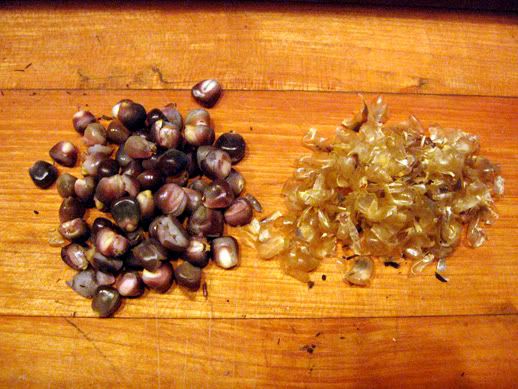

I used a mortar and pestle in place of the traditional Mayan metate y mano. They say the stone grinder adds more minerals to your meal, but archaeologists say that it also works like sand paper on your teeth! The Seneca had a smarter idea and used giant wooden mortar and pestles.
I felt concerned about grinding the hulls in with everything. I mean, I thought the whole point of nixtamalizing involves removing the hulls. But maybe it just means loosening them from the germ. I don’t know.
It did not grind very easily. I spent 20 minutes grinding it before I realized it didn’t work very well. I got a wet clump of corn:

I waited for it to dry than I ground it finer to make the taco. It worked okay, but still took a lot of fucking elbow grease!
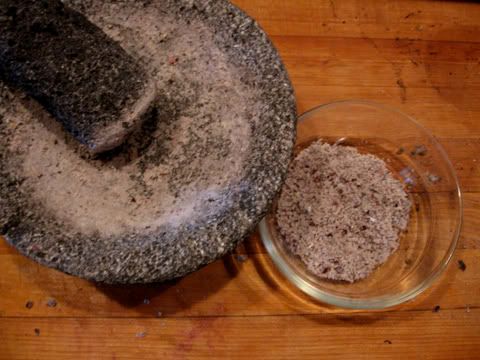
…add a little water and roll it into a ball… get out the press…

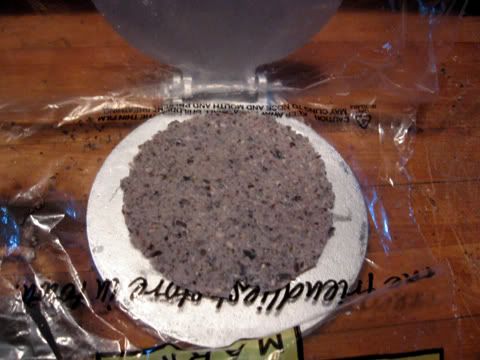
Cook it up. No oil, just hot hot heat.
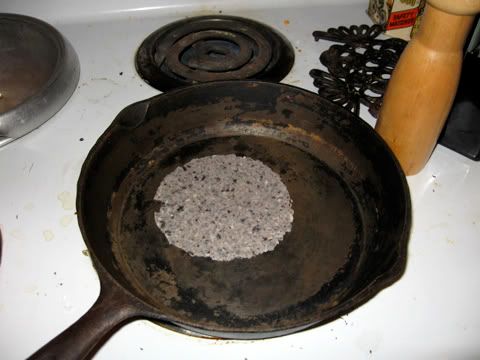
One taco… to share with my girlfriend.
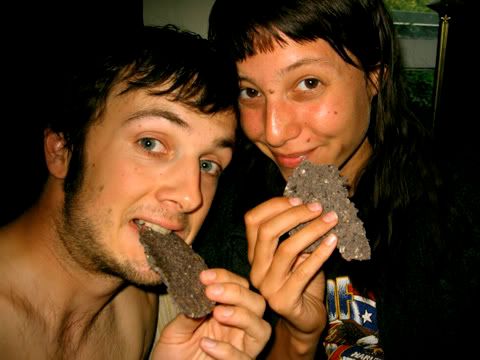
So where do I go from here? Well, as you know I quit corn for awhile, but I came crawling back. So now I have a few ideas. I want to try the slaked lime recipe. I found a Mexican place that sells it and also sells a different kind of blue corn than the one I tried before. So, two kinds of blue corn, with slaked lime. I also want to try it with a shit load more ash this time and see if I only need to boil it for 30 minutes. I also want to get a corn grinder so I don’t have to use that awful mortar and pestle. Perhaps Penny and I will make our own giant wooden mortal and pestle this summer… who knows? Stay tuned for more nixtamal experiments.
—
Show your support and appreciation for Urban Scout
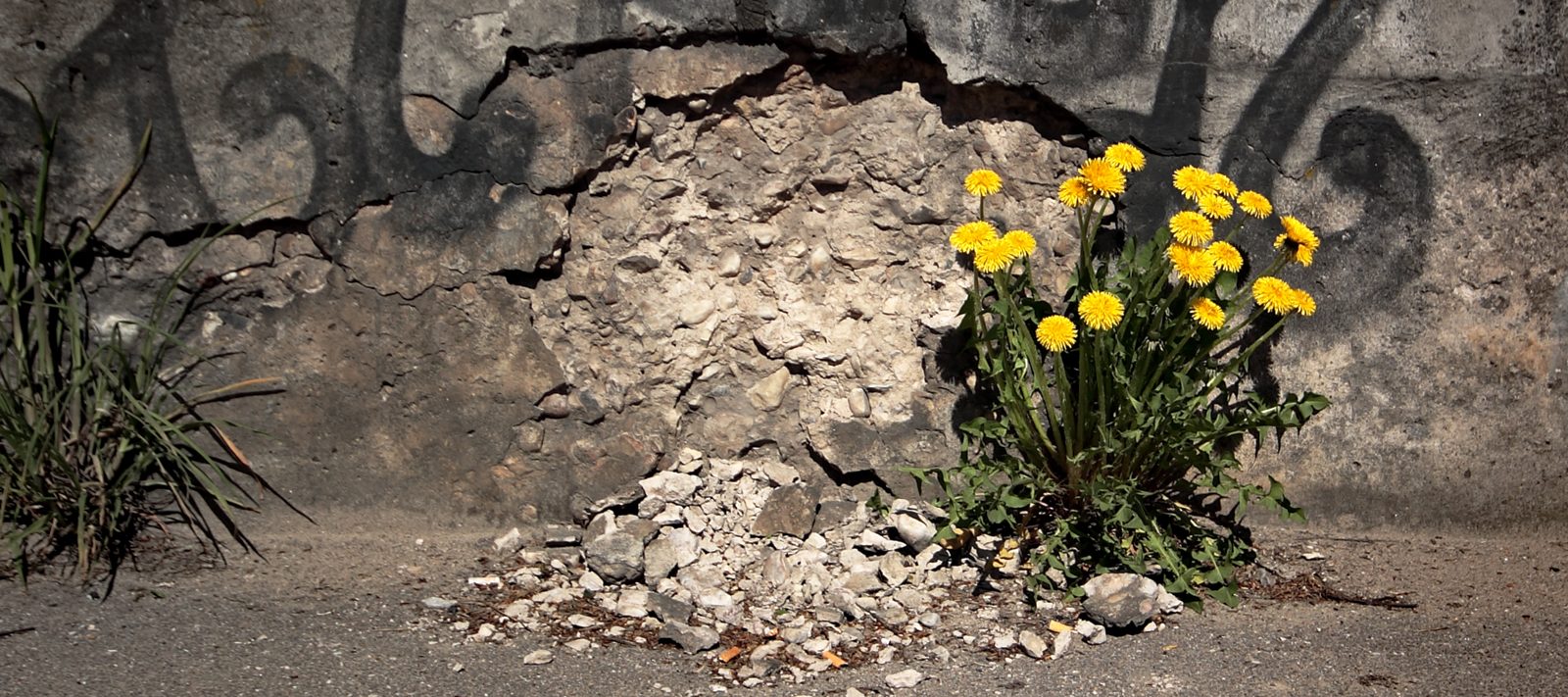

i’m having the same problem with sweet chestnuts. so far i cant get all the pith off like the commercially bought ones.
regards
SBW
Dear Scout and Penny,
Wow! I am about to have lunch, watched the video of an incredible soup in the making, and then watched you… verified with your tatoo, and think … oh golly day. I am so happy that you ended up with something to eat after all your trials and errors. Success!!!!
I think I will now make myself some lentil soup, yes it is easy, just add a few things such as garlic and what ever else that happens to be lying around, but no way will I take 10 days to make a communal soup!
Cheers!
Christine
Have you considered increasing the amount of calcium oxide (also known as quicklime) by cooking drywall. There are many methods on the net for getting quicklime from from drywall. This chemical comes in handy in other applications as well. I know it’s not natural per say but you could think of it as harvesting the urban bounty.
Good Luck
D
Just wanted to say your style of writing is great and it was fun to read your article. I too was looking for a way to make corn tortillas. I travel a bit, and getting corn flour and the such is bit difficult in many countries, so I wanted to see what I could find online, and that is how I came across your site…it was a great surprise.
Take care,
F
Thanks for the feedback everyone.
Darrin, I’m definately going to look into the drywall thing.
Fede, thanks for the props!
Thanks for your blog. I too am trying to make tortillas. I am in the Philippines and there is plenty of corn and plenty of ground corn but this nixtamal process is left out here. I have tryed every different grind they have and my tortillas always come out gritty with no snap to my chips. If you find a simple process to make good tortillas let me know.
Haha. Thanks William. If you find anything, please report back to me as well! I’m going to try a few more experiments here in a while.
I got myself a bit obsessed with this process last year, and I’ve been eating a hell of a lot of tortillas since then, and loving it.
we use 1 Tbsp cal to 2 cups dried corn, boil for an hour, soak overnight, rinse A LOT and grind. I haven’t had any luck with the husk thing, though…
I haven’t tried the ash yet (inexcuseable, since we heat with wood), but I read somewhere to use 1 or 2 cups ash per gallon dried corn.
Went through a similar process for tamales yesterday (and today). Experimented a bit, with techiques for getting the hulls off;
1) Rubbed the corn together in my hands (limited success).
2) Rubbed the corn between two dishtowels (better, 50% hulls)
3) Blended the corn in water with one beater, from my hand mixer (best results, got about 70% of the hulls).
Food grade calcium carbonate (lime) is pretty easy to find. I used about 3 Tablespoons for 2 lbs of dried corn. A store that stocks canning supplies should have it – often called pickling lime.
Found an online source (Grandma Gertie’s Cooking Supplies) – $2.88 for 2 oz.
I have had excellent success using pickling lime, calcium hydroxide. I put 5 Tablespoons of lime in 4 quarts of water and 2 quarts of corn. Boil this a few minutes and then turn off the heat and let it soak for 24 hours (put it in the fridge). Then pour off the lime water and rinse the corn really good. The hulls dissolve for the most part, but you have to rub off the ends. You don’t have to remove all the little end-caps, just grind them up too.
Grind the nixtamal wet (I use a cheap hand grain mill). Add just a little hot water, and you have masa. This makes about 4 quarts of masa, so you may want to freeze some for later. I get about 60 tortillas from a batch this size.
I appreciate the adaptations from the ancient method used, however there’s a good reason why the basic recipe has been used century after century: namely, it WORKS! It’s about keeping it simple, and less labor intensive, and therefore far more enjoyable of a process!
2 lbs dent corn
3 tbs calcium hydroxide(slaked lime, ‘cal’)
5 quarts water
method:
in a nonreactive(stainless steel, enamel or earthenware) pot, add first the water then the ‘cal’ and after mixing the ‘cal’ well into the water, the corn. You should notice the corn turn to a vibrant yellow, almost immediately.
Bring mixture to a boil, then reduce to a simmer for about 20-25 minutes. Remove from heat and allow to cool, covered, for approximately 8 hours(less for tamale masa). Refridgeration is not only unnecessary, it’s also a huge strain on your appliance. The corn should not be mushy, if it is, it’s been cooked too long. The texture that achieves consistently perfect masa should be more firm than pasta done ‘al dente’ – so, still quite firm to the touch. The ideal is to end up with a dry masa once it’s been ground; it’s much EASIER to work with.
Rinse well, rubbing the corn(now nixtamal)to sluff off any remaining skin. This should not be a laborious chore, where you are reduced to picking the skin off with your fingers for hours on end. If you find that you are spending too much time on this stage, you have used too little ‘cal’ or an insufficient agent.
Strain the nixtamal well, then transfer to a dry cloth towel(a big, thick, absorbent beach towel works well) – allow the nixtamal to dry for several hours; press between another towel for a quicker drying time.
Now to the grinding:
Here’s where you reap the rewards for not overcooking the corn – as well as for drying the nixtamal before grinding. If you’ve stood at the grinder for hours, trickle-feeding a viscousy nixtamal through the grinder for a second pass to make a finer masa, you’ll want to slap yourself once you try this method! If you’ve dried the nixtamal well enough, you will only need to pass it through your grinder ONCE!
Since you will be working now with masa that is more like flour instead of peanut butter, you will need to add water(and salt to taste) to achieve the proper consistency for making tortillas.
Everyone who is reading this most likely knows how to take it from here…
What a great article! I’m personally sticking with the wood ash because calcium in all its many forms has been overly hyped in the US. The primary reason for nixtaml is that it releases important nutrients within the corn. I don’t know how the ancients knew this.
burning sea shells in a fire and then crushing them is a good source of calcium oxide.
I Am retared in Thailand,Thailanese do not have any glue about corn tortillas or any thing what to do with corn,they beleve it is for animal food only.
I am a Mexican I do lick to eat my food some time, so I need to start making tortillas from scrach,thank You for your inf. please be free to conntact me any time Sam God.
You have inspired me to try this. I have some books by C. Keith Wilbur on Native American crafts and life skills. I seem to remember that you take a couple handfuls of hard wood ash in some water (half to a whole gallon, estimate from the picture) Then boil it awhile. After it cools and ash settled, pour off the top into another container. The top water is now lye, so do not touch it, it’s caustic. Soak the corn in it awhile, no sure how long, maybe a day? You should see the husks come off if you stir. Then without touching the lye rinse. I think these rinsed it some then placed in a container in a stream for maybe another day. When the lye is all gone, it is ready to grind. I will tell how my experiment goes too.
I am so happy to find this information. I’ve looked all over the internet and have tried to use the Wild Fermentation recipe twice. I also found a recipe in one of Rick Bayless’ books on Mexican Cooking. I’ve never been able to get the hulls off the corn! They are not attached to the kernel any more, but they are at the tip of the kernel and I absolutely refuse to pick all of these hulls off. I have used wood ash from oak burned in my woodstove as directed in Wild Fermentation. This time, I’m going to just grind the mess and try to make tamales. Next time, I think I’ll add more ash, just like you said. It seems natural, everybody says it works, and it’s free.
Dry the corn after you take it out of the lye water. I’m drying mine rock hard, then grinding with a coffee grinder.
You can use an enormous amount of wood ashes. I boiled a huge batch of ashes for many days resulting in good strong lye water. Each morning, I took out the spent ashes and put some new ashes into the lye pot. I added water each day. When the lye water felt soapy/slippery, I let it settle and put the cleanest lye water on my corn. I only needed 1 or 2 days to make lye water because it was simmering on the stove all that time. I decided that my lye water was pretty harmless if I rinse the corn well afterwards, so I didn’t test the pH.
I am using a variety of corn known as Painted Mountain Corn, an organic dent corn with good color. It is a northern variety that does well locally (New Hampshire.) I’m keeping my husks on for their color and fiber. My goal is 1.) find a way to use the ash from my wood-stove so that it won’t be chemically active when I put it into the garden; and 2.) find a way to make corn safer for me to eat (that means wheat-free and mild enough to deal with my poor digestion.)
I found your blog a year or two ago when trying to figure this out myself. It was a long arduous process. Glad you found your way. I no longer try to use my own ashes. You can find a good recipe and buy a good slake lime on Gourmet Sleuth. I even bought a metata! I grind mine and use it wet. It is wonderful.
thanx for sharing your experience…now I don’t feel alone! I thought it was just me that couldn’t figure things out. I too am still working on the best tasting & easiest process. The grinding is the problem for me even though I have the traditional metal grinder, I have to pass it many times and when getting to the fine grinding, the metal plates start to leave a greyish/black residue. Any suggestions?
I just made some masa the other day using Indian corn I grew in my garden. I used pickling lime as mentioned above. The reason you can’t get the hulls off of blue corn or Indian corn like I used is because there just isn’t that much of a hull. If you used commercial grown dent corn that has a really thick hull on it. I never tried making masa using dent corn, but with what I use I don’t bother trying to wash the hulls off because they are not a problem. I used a Corona Grain mill to grind the masa.
For years I never made masa because I thought it was some hard process but there really is not much to it . It makes the best tamales ever !